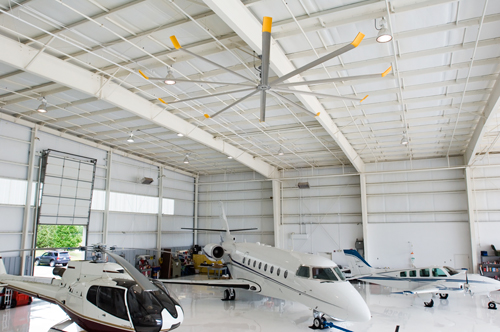Large, Low Velocity Fans: Making Energy Efficiency a Breeze
These large fans operate with variable speed drives (VSD), allowing operation at higher speeds in summer and at lower speeds in winter. They typically have small motors ranging in size from 1/3 horsepower to 2 horsepower, and are used for cooling, heat recirculation, air distribution and as alternatives to air conditioning in large facilities. They are vastly more effective than high-speed fans, moving up to 36 times as much air. Also, due to their low operating speed, large, low velocity fans are very quiet.
Airflow Concept |
 |
Large, low velocity fans use their immense size – not speed – and aerodynamic airfoil and winglet design to move large volumes of air. Photo courtesy of Big Ass Fan Company® |
Large, low velocity fans were invented more than a decade ago for large industrial and agricultural settings as an alternative to multiple conventional high speed fans, those large, caged fans that are typically freestanding or wall-mounted. The construction of these high speed fans and the speed at which their blades move make them unavoidably noisy. In fact, the fans can produce more than 85 decibels of noise, sometimes requiring hearing protection. While they do move a considerable amount of air, the air is circulated directly in front of the fan, providing some cooling in limited areas with little mixing of air or heat recirculation, the thermal differential that naturally occurs as heat rises. Moreover, the high velocity of the air moved by these smaller fans is uncomfortable and disruptive for people and, in agricultural settings, for animals stationed directly in the airflow stream. Finally, the sheer quantity of the smaller fans needed to make a large space comfortable create additional safety concerns, equipment maintenance and operating cost issues.
With their superior airflow, energy efficiency, and quiet operation, large, low velocity fans rapidly gained acceptance in agricultural settings, and also were quick to be adopted as a cooling alternative for spaces where air conditioning was impractical or too expensive. Today, HVLS fans are recognized as a technology with wide application and proven results in reducing or eliminating the cost of mechanical cooling for large spaces.
Operating Principles
Air is stratified into warm and cool layers, with the warmest air rising to the ceiling. It is not unusual for the temperature at the ceiling in tall, heated spaces in the winter to be 10 to 20 degrees Fahrenheit warmer than it is at floor level. Proper use of large, low velocity ceiling fans can virtually eliminate this stratification by gently driving the ceiling air downward and properly mixing the air to eliminate hot and cold spots. Using large, low velocity fans to maintain a constant air temperature throughout the space, building operators can reduce heat loss through walls and the roof and save up to 30% on heating costs. Moreover, during seasonal transitional periods, large, low velocity fans can be run on slow speed to bring the heat down from the ceiling, delaying startup of the heating system in the fall and enabling early shutdown in the spring.
With their slow turning, quiet, non-disruptive air movement, HVLS fans are increasingly used in office spaces. For Jonathan Arnold, founder of Arnold Imaging, the concern was heating an office that has 20-foot ceilings, uninsulated concrete floors and four 16-foot wide garage doors that flank the space. Arnold was reluctant to heat the 10 feet directly below the ceiling to 90 °F to get the bottom of the space to feel remotely comfortable. With a large, low velocity ceiling fan, slow air movement gave Arnold Imaging the ability to push that heat back down in winter and reduce the average temperature of the space.
Arnold reports flipping on a switch and feeling the effect of having natural air, rather than cold or hot air. "Instead of having 25 separate fans running, there are two big fans that cover the whole office," says Arnold, who appreciates the aesthetic and energy-saving properties of a large fan. Smaller ceiling fans are designed to reverse direction, pulling warm air to the ceiling and across the walls. This can increase heat loss through the roof and also increases energy use as the fan must run at high speeds to move enough air. With large, low velocity ceiling fans, the fan is slowed – not reversed – to redirect warm air to the floor. Because the fan only operates at a fraction of its maximum speed, the hot air is pushed down without creating a draft (which typically occurs at 30 feet per minute).
In hot weather, fans are operated at the upper range of speed to create a cooling breeze. People are cooled by the breeze that is created, even though the temperature has not been lowered; it is this cooling effect that makes building occupants feel cooler and more comfortable. The circulation results in an even temperature throughout the area covered by the large fan, eliminating hot and cold spots that can often plague large spaces.
 |
Large, low velocity ceiling fans worked to eliminate condensation on the aircraft. Photo Courtesy of Big Ass Fans® |









